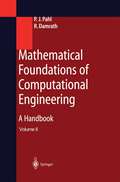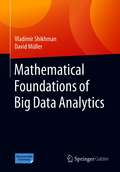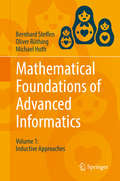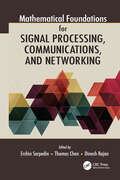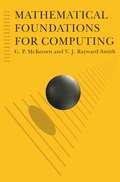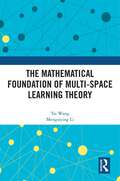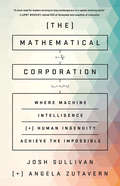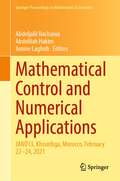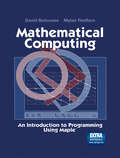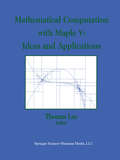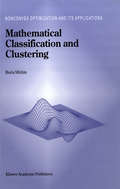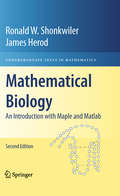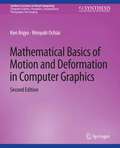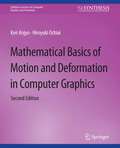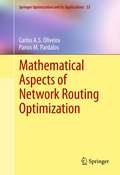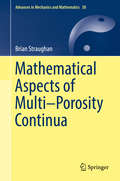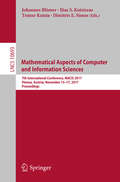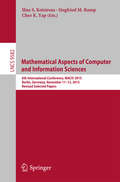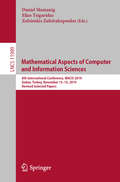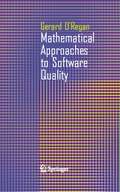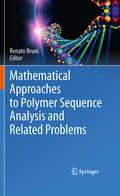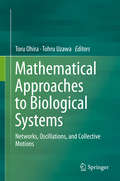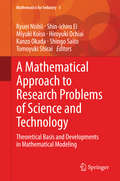- Table View
- List View
Mathematical Foundations of Computational Engineering: A Handbook
by Peter J. Pahl Rudolf DamrathComputational engineering is the treatment of engineering tasks with computers. It is based on computational mathematics, which is presented here in a comprehensive handbook. From the existing rich repertoire of mathematical theories and methods, the fundamentals of engineering computation are here presented in a coherent fashion. They are brought into a suitable order for specific engineering purposes, and their significance for typical applications shown. The relevant definitions, notations and theories are presented in a durable form which is independent of the fast development of information and communication technology.
Mathematical Foundations of Big Data Analytics
by Vladimir Shikhman David MüllerIn this textbook, basic mathematical models used in Big Data Analytics are presented and application-oriented references to relevant practical issues are made. Necessary mathematical tools are examined and applied to current problems of data analysis, such as brand loyalty, portfolio selection, credit investigation, quality control, product clustering, asset pricing etc. – mainly in an economic context. In addition, we discuss interdisciplinary applications to biology, linguistics, sociology, electrical engineering, computer science and artificial intelligence. For the models, we make use of a wide range of mathematics – from basic disciplines of numerical linear algebra, statistics and optimization to more specialized game, graph and even complexity theories. By doing so, we cover all relevant techniques commonly used in Big Data Analytics.Each chapter starts with a concrete practical problem whose primary aim is to motivate the study of a particular Big Data Analytics technique. Next, mathematical results follow – including important definitions, auxiliary statements and conclusions arising. Case-studies help to deepen the acquired knowledge by applying it in an interdisciplinary context. Exercises serve to improve understanding of the underlying theory. Complete solutions for exercises can be consulted by the interested reader at the end of the textbook; for some which have to be solved numerically, we provide descriptions of algorithms in Python code as supplementary material.This textbook has been recommended and developed for university courses in Germany, Austria and Switzerland.
Mathematical Foundations of Advanced Informatics: Volume 1: Inductive Approaches
by Bernhard Steffen Oliver Rüthing Michael HuthThe books in this trilogy capture the foundational core of advanced informatics. The authors make the foundations accessible, enabling students to become effective problem solvers.This first volume establishes the inductive approach as a fundamental principle for system and domain analysis. After a brief introduction to the elementary mathematical structures, such as sets, propositional logic, relations, and functions, the authors focus on the separation between syntax (representation) and semantics (meaning), and on the advantages of the consistent and persistent use of inductive definitions. They identify compositionality as a feature that not only acts as a foundation for algebraic proofs but also as a key for more general scalability of modeling and analysis. A core principle throughout is invariance, which the authors consider a key for the mastery of change, whether in the form of extensions, transformations, or abstractions.This textbook is suitable for undergraduate and graduate courses in computer science and for self-study. Most chapters contain exercises and the content has been class-tested over many years in various universities.
Mathematical Foundations for Signal Processing, Communications, and Networking
by Erchin Serpedin, Thomas Chen and Dinesh RajanMathematical Foundations for Signal Processing, Communications, and Networking describes mathematical concepts and results important in the design, analysis, and optimization of signal processing algorithms, modern communication systems, and networks. Helping readers master key techniques and comprehend the current research literature, the book offers a comprehensive overview of methods and applications from linear algebra, numerical analysis, statistics, probability, stochastic processes, and optimization. From basic transforms to Monte Carlo simulation to linear programming, the text covers a broad range of mathematical techniques essential to understanding the concepts and results in signal processing, telecommunications, and networking. Along with discussing mathematical theory, each self-contained chapter presents examples that illustrate the use of various mathematical concepts to solve different applications. Each chapter also includes a set of homework exercises and readings for additional study. This text helps readers understand fundamental and advanced results as well as recent research trends in the interrelated fields of signal processing, telecommunications, and networking. It provides all the necessary mathematical background to prepare students for more advanced courses and train specialists working in these areas.
Mathematical Foundations for Signal Processing, Communications, and Networking
by Erchin Serpedin Thomas Chen Dinesh RajanMathematical Foundations for Signal Processing, Communications, and Networking describes mathematical concepts and results important in the design, analysis, and optimization of signal processing algorithms, modern communication systems, and networks. Helping readers master key techniques and comprehend the current research literature, the book offers a comprehensive overview of methods and applications from linear algebra, numerical analysis, statistics, probability, stochastic processes, and optimization. From basic transforms to Monte Carlo simulation to linear programming, the text covers a broad range of mathematical techniques essential to understanding the concepts and results in signal processing, telecommunications, and networking. Along with discussing mathematical theory, each self-contained chapter presents examples that illustrate the use of various mathematical concepts to solve different applications. Each chapter also includes a set of homework exercises and readings for additional study. This text helps readers understand fundamental and advanced results as well as recent research trends in the interrelated fields of signal processing, telecommunications, and networking. It provides all the necessary mathematical background to prepare students for more advanced courses and train specialists working in these areas.
Mathematical Foundations for Computing (Computer Science Series)
by G.P. McKeownThis text gives a clear, but rigorous description of the fundamental mathematical concepts used by computer scientists, while at the same time emphasising the need for careful justification. The authors provide proofs of all the major results; all the algorithms presented are developed carefully and their performance is analysed. Throughout, the aim is to provide a well balanced treatment of both the discrete and continuous mathematics that should be studied by the serious student of computer science. The book will therefore be most suited to those undergraduate programmes that put the emphasis on such areas as programming language semantics, program correctness, and algorithm analysis and design.
The Mathematical Foundation of Multi-Space Learning Theory
by Tai Wang Mengsiying LiThis book explores the measurement of learning effectiveness and the optimization of knowledge retention by modeling the learning process and building the mathematical foundation of multi-space learning theory.Multi-space learning is defined in this book as a micro-process of human learning that can take place in more than one space, with the goal of effective learning and knowledge retention. This book models the learning process as a temporal sequence of concept learning, drawing on established principles and empirical evidence. It also introduces the matroid to strengthen the mathematical foundation of multi-space learning theory and applies the theory to vocabulary and mathematics learning, respectively. The results show that, for vocabulary learning, the method can be used to estimate the effectiveness of a single learning strategy, to detect the mutual interference that might exist between learning strategies, and to predict the optimal combination of strategies. In mathematical learning, it was found that timing is crucial in both first learning and second learning in scheduling optimization to maximize the intersection effective interval.The title will be of interest to researchers and students in a wide range of areas, including educational technology, learning sciences, mathematical applications, and mathematical psychology.
The Mathematical Foundation of Multi-Space Learning Theory
by Tai Wang Mengsiying LiThis book explores the measurement of learning effectiveness and the optimization of knowledge retention by modeling the learning process and building the mathematical foundation of multi-space learning theory.Multi-space learning is defined in this book as a micro-process of human learning that can take place in more than one space, with the goal of effective learning and knowledge retention. This book models the learning process as a temporal sequence of concept learning, drawing on established principles and empirical evidence. It also introduces the matroid to strengthen the mathematical foundation of multi-space learning theory and applies the theory to vocabulary and mathematics learning, respectively. The results show that, for vocabulary learning, the method can be used to estimate the effectiveness of a single learning strategy, to detect the mutual interference that might exist between learning strategies, and to predict the optimal combination of strategies. In mathematical learning, it was found that timing is crucial in both first learning and second learning in scheduling optimization to maximize the intersection effective interval.The title will be of interest to researchers and students in a wide range of areas, including educational technology, learning sciences, mathematical applications, and mathematical psychology.
The Mathematical Corporation: Where Machine Intelligence and Human Ingenuity Achieve the Impossible
by Angela Zutavern Josh SullivanThe most powerful weapon in business today is the alliance between the mathematical smarts of machines and the imaginative human intellect of great leaders. Together they make the mathematical corporation, the business model of the future. We are at a once-in-a-decade breaking point similar to the quality revolution of the 1980s and the dawn of the internet age in the 1990s: leaders must transform how they run their organizations, or competitors will bring them crashing to earth--often overnight. Mathematical corporations--the organizations that will master the future--will outcompete high-flying rivals by merging the best of human ingenuity with machine intelligence. While smart machines are weapon number one for organizations, leaders are still the drivers of breakthroughs. Only they can ask crucial questions to capitalize on business opportunities newly discovered in oceans of data. This dynamic combination will make possible the fulfillment of missions that once seemed out of reach, even impossible to attain. Josh Sullivan and Angela Zutavern's extraordinary examples include the entrepreneur who upended preventive health care, the oceanographer who transformed fisheries management, and the pharmaceutical company that used algorithm-driven optimization to boost vaccine yields. Together they offer a profoundly optimistic vision for a dazzling new phase in business, and a playbook for how smart companies can manage the essential combination of human and machine.
Mathematical Control and Numerical Applications: JANO13, Khouribga, Morocco, February 22–24, 2021 (Springer Proceedings in Mathematics & Statistics #372)
by Abdeljalil Nachaoui Abdelilah Hakim Amine LaghribThis book presents some sufficient mathematical content with expressive result. The aim of JANO13 is to bring together scientists to discuss their research in all the aspects of mathematics and their applications to different scientific discipline. The main topics of the conference is partial differential equations, mathematical control, numerical analysis and computer science. The conference is interested in recent developments on numerical analysis and real applications in computer science. The latter is viewed as a dynamic branch on the interface of mathematics and informatics that has been growing rapidly over the past several decades. However, its mathematical modelling and interpretation are still not well-explained and need much more clarifications. The main contributions of this book are to give some sufficient mathematical content with expressive results. As a growing field, it is gaining a lot of attention both in media and in the industry world, which will attract the interest of readers from different scientist disciplines.
Mathematical Computing: An Introduction to Programming Using Maple®
by David Betounes Mylan RedfernThis book teaches introductory computer programming using Maple, offering more mathematically oriented exercises and problems than those found in traditional programming courses, while reinforcing and applying concepts and techniques of calculus. Includes case studies.
Mathematical Computation with Maple V: Proceedings of the Maple Summer Workshop and Symposium, University of Michigan, Ann Arbor, June 28–30, 1993
by Thomas LeeDevelopments in both computer hardware and Perhaps the greatest impact has been felt by the software over the decades have fundamentally education community. Today, it is nearly changed the way people solve problems. impossible to find a college or university that has Technical professionals have greatly benefited not introduced mathematical computation in from new tools and techniques that have allowed some form, into the curriculum. Students now them to be more efficient, accurate, and creative have regular access to the amount of in their work. computational power that were available to a very exclusive set of researchers five years ago. This Maple V and the new generation of mathematical has produced tremendous pedagogical computation systems have the potential of challenges and opportunities. having the same kind of revolutionary impact as high-level general purpose programming Comparisons to the calculator revolution of the languages (e.g. FORTRAN, BASIC, C), 70's are inescapable. Calculators have application software (e.g. spreadsheets, extended the average person's ability to solve Computer Aided Design - CAD), and even common problems more efficiently, and calculators have had. Maple V has amplified our arguably, in better ways. Today, one needs at mathematical abilities: we can solve more least a calculator to deal with standard problems problems more accurately, and more often. In in life -budgets, mortgages, gas mileage, etc. specific disciplines, this amplification has taken For business people or professionals, the excitingly different forms.
Mathematical Classification and Clustering (Nonconvex Optimization and Its Applications #11)
by Boris MirkinI am very happy to have this opportunity to present the work of Boris Mirkin, a distinguished Russian scholar in the areas of data analysis and decision making methodologies. The monograph is devoted entirely to clustering, a discipline dispersed through many theoretical and application areas, from mathematical statistics and combina torial optimization to biology, sociology and organizational structures. It compiles an immense amount of research done to date, including many original Russian de velopments never presented to the international community before (for instance, cluster-by-cluster versions of the K-Means method in Chapter 4 or uniform par titioning in Chapter 5). The author's approach, approximation clustering, allows him both to systematize a great part of the discipline and to develop many in novative methods in the framework of optimization problems. The optimization methods considered are proved to be meaningful in the contexts of data analysis and clustering. The material presented in this book is quite interesting and stimulating in paradigms, clustering and optimization. On the other hand, it has a substantial application appeal. The book will be useful both to specialists and students in the fields of data analysis and clustering as well as in biology, psychology, economics, marketing research, artificial intelligence, and other scientific disciplines. Panos Pardalos, Series Editor.
Mathematical Biology: An Introduction with Maple and Matlab (Undergraduate Texts in Mathematics)
by Ronald W. Shonkwiler James HerodMathematical Basics of Motion and Deformation in Computer Graphics, Second Edition (Synthesis Lectures on Visual Computing: Computer Graphics, Animation, Computational Photography and Imaging)
by Ken Anjyo Hiroyuki OchiaiThis synthesis lecture presents an intuitive introduction to the mathematics of motion and deformation in computer graphics. Starting with familiar concepts in graphics, such as Euler angles, quaternions, and affine transformations, we illustrate that a mathematical theory behind these concepts enables us to develop the techniques for efficient/effective creation of computer animation. This book, therefore, serves as a good guidepost to mathematics (differential geometry and Lie theory) for students of geometric modeling and animation in computer graphics. Experienced developers and researchers will also benefit from this book, since it gives a comprehensive overview of mathematical approaches that are particularly useful in character modeling, deformation, and animation.
Mathematical Basics of Motion and Deformation in Computer Graphics (Synthesis Lectures on Computer Graphics and Animation)
by Hiroyuki Ochiai Ken AnjyoThis synthesis lecture presents an intuitive introduction to the mathematics of motion and deformation in computer graphics. Starting with familiar concepts in graphics, such as Euler angles, quaternions, and affine transformations, we illustrate that a mathematical theory behind these concepts enables us to develop the techniques for efficient/effective creation of computer animation. This book, therefore, serves as a good guidepost to mathematics (differential geometry and Lie theory) for students of geometric modeling and animation in computer graphics. Experienced developers and researchers will also benefit from this book, since it gives a comprehensive overview of mathematical approaches that are particularly useful in character modeling, deformation, and animation. Table of Contents: Preface / Symbols and Notations / Introduction / Rigid Transformation / Affine Transformation / Exponential and Logarithm of Matrices / 2D Affine Transformation between Two Triangles / Global 2D Shape Interpolation / Parametrizing 3D Positive Affine Transformations / Further Readings / Bibliography / Authors' Biographies
Mathematical Aspects of Network Routing Optimization (Springer Optimization and Its Applications #53)
by Carlos A.S. Oliveira Panos M. PardalosBefore the appearance of broadband links and wireless systems, networks have been used to connect people in new ways. Now, the modern world is connected through large-scale, computational networked systems such as the Internet. Because of the ever-advancing technology of networking, efficient algorithms have become increasingly necessary to solve some of the problems developing in this area."Mathematical Aspects of Network Routing Optimization" focuses on computational issues arising from the process of optimizing network routes, such as quality of the resulting links and their reliability. Algorithms are a cornerstone for the understanding of the protocols underlying multicast routing. The main objective in the text is to derive efficient algorithms, with or without guarantee of approximation. Notes have been provided for basic topics such as graph theory and linear programming to assist those who are not fully acquainted with the mathematical topics presented throughout the book."Mathematical Aspects of Network Routing Optimization" provides a thorough introduction to the subject of algorithms for network routing, and focuses especially on multicast and wireless ad hoc systems. This book is designed for graduate students, researchers, and professionals interested in understanding the algorithmic and mathematical ideas behind routing in computer networks. It is suitable for advanced undergraduate students, graduate students, and researchers in the area of network algorithms.
Mathematical Aspects of Multi–Porosity Continua (Advances in Mechanics and Mathematics #38)
by Brian StraughanThis book is devoted to describing theories for porous media where such pores have an inbuilt macro structure and a micro structure. For example, a double porosity material has pores on a macro scale, but additionally there are cracks or fissures in the solid skeleton. The actual body is allowed to deform and thus the underlying theory is one of elasticity. Various different descriptions are reviewed. Chapter 1 introduces the classical linear theory of elastodynamics together with uniqueness and continuous dependence results. Chapters 2 and 3 review developments of theories for double and triple porosity using a pressure-displacement structure and also using voids-displacement. Chapter 4 compares various aspects of the pressure-displacement and voids-displacement theories via uniqueness studies and wave motion analysis. Mathematical analyses of double and triple porosity materials are included concentrating on uniqueness and stability studies in chapters 5 to 7. In chapters 8 and 9 the emphasis is on wave motion in double porosity materials with special attention paid to nonlinear waves. The final chapter embraces a novel area where an elastic body with a double porosity structure is analyzed, but the thermodynamics allows for heat to travel as a wave rather than simply by diffusion. This book will be of value to mathematicians, theoretical engineers and other practitioners who are interested in double or triple porosity elasticity and its relevance to many diverse applications.
Mathematical Aspects of Computer and Information Sciences: 7th International Conference, MACIS 2017, Vienna, Austria, November 15-17, 2017, Proceedings (Lecture Notes in Computer Science #10693)
by Johannes Blömer Ilias S. Kotsireas Temur Kutsia Dimitris E. SimosThis book constitutes the refereed proceedings of the 7th International Conference on Mathematical Aspects of Computer and Information Sciences, MACIS 2017, held in Vienna, Austria, in November 2017. The 28 revised papers and 8 short papers presented were carefully reviewed and selected from 67 submissions. The papers are organized in the following topical sections: foundation of algorithms in mathematics, engineering and scientific computation; combinatorics and codes in computer science; data modeling and analysis; and mathematical aspects of information security and cryptography.
Mathematical Aspects of Computer and Information Sciences: 6th International Conference, MACIS 2015, Berlin, Germany, November 11-13, 2015, Revised Selected Papers (Lecture Notes in Computer Science #9582)
by Ilias S. Kotsireas Siegfried M. Rump Chee K. YapThis book constitutes the thoroughly refereed post-conference proceedings of the 6th International Conference on Mathematical Aspects of Computer and Information Sciences, MACIS 2015, held in Berlin, Germany, in November 2015. The 48 revised papers presented together with 7 invited papers were carefully reviewed and selected from numerous submissions. The papers are grouped in topical sections on curves and surfaces, applied algebraic geometry, cryptography, verified numerical computation, polynomial system solving, managing massive data, computational theory of differential and difference equations, data and knowledge exploration, algorithm engineering in geometric computing, real complexity: theory and practice, global optimization, and general session.
Mathematical Aspects of Computer and Information Sciences: 8th International Conference, MACIS 2019, Gebze, Turkey, November 13–15, 2019, Revised Selected Papers (Lecture Notes in Computer Science #11989)
by Daniel Slamanig Elias Tsigaridas Zafeirakis ZafeirakopoulosThis book constitutes the refereed proceedings of the 8th International Conference on Mathematical Aspects of Computer and Information Sciences, MACIS 2019, held in Gebze, Turkey, in November 2019. The 22 revised papers and 14 short papers presented were carefully reviewed and selected from 66 submissions. The papers are organized in the following topical sections: algorithms and foundation; security and cryptography; combinatorics, codes, designs and graphs; data modeling and machine learning; tools and software track.
Mathematical Approaches to Software Quality
by Gerard O'ReganThis book provides a comprehensive introduction to various mathematical approaches to achieving high-quality software. An introduction to mathematics that is essential for sound software engineering is provided as well as a discussion of various mathematical methods that are used both in academia and industry. The mathematical approaches considered include: Z specification language Vienna Development Methods (VDM) Irish school of VDM (VDM) approach of Dijkstra and Hoare classical engineering approach of Parnas Cleanroom approach developed at IBM software reliability, and unified modelling language (UML). Additionally, technology transfer of the mathematical methods to industry is considered. The book explains the main features of these approaches and applies mathematical methods to solve practical problems. Written with both student and professional in mind, this book assists the reader in applying mathematical methods to solve practical problems that are relevant to software engineers.
Mathematical Approaches to Polymer Sequence Analysis and Related Problems
by Renato BruniAn edited volume describing the latest developments in approaching the problem of polymer sequence analysis, with special emphasis on the most relevant biopolymers (peptides and DNA) but not limited to them. The chapters will include peptide sequence analysis, DNA sequence analysis, analysis of biopolymers and nonpolymers, sequence alignment problems, and more.
Mathematical Approaches to Biological Systems: Networks, Oscillations, and Collective Motions
by Toru Ohira Tohru UzawaThis book presents the most recent mathematical approaches to the growing research area of networks, oscillations, and collective motions in the context of biological systems. Bringing together the results of multiple studies of different biological systems, this book sheds light on the relations among these research themes. Included in this book are the following topics: feedback systems with time delay and threshold of sensing (dead zone), robustness of biological networks from the point of view of dynamical systems, the hardware-oriented neuron modeling approach, a universal mechanism governing the entrainment limit under weak forcing, the robustness mechanism of open complex systems, situation-dependent switching of the cues primarily relied on by foraging ants, and group chase and escape.Research on different biological systems is presented together, not separated by specializations or by model systems. Therefore, the book provides diverse perspectives at the forefront of current mathematical research on biological systems, especially focused on networks, oscillations, and collective motions.This work is aimed at advanced undergraduate, graduate, and postdoctoral students, as well as scientists and engineers. It will also be of great use for professionals in industries and service sectors owing to the applicability of topics such as networks and synchronizations.
A Mathematical Approach to Research Problems of Science and Technology: Theoretical Basis and Developments in Mathematical Modeling (Mathematics for Industry #5)
by Ryuei Nishii Shin-Ichiro Ei Miyuki Koiso Hiroyuki Ochiai Kanzo Okada Shingo Saito Tomoyuki ShiraiThis book deals with one of the most novel advances in mathematical modeling for applied scientific technology, including computer graphics, public-key encryption, data visualization, statistical data analysis, symbolic calculation, encryption, error correcting codes, and risk management. It also shows that mathematics can be used to solve problems from nature, e.g., slime mold algorithms.One of the unique features of this book is that it shows readers how to use pure and applied mathematics, especially those mathematical theory/techniques developed in the twentieth century, and developing now, to solve applied problems in several fields of industry. Each chapter includes clues on how to use "mathematics" to solve concrete problems faced in industry as well as practical applications.The target audience is not limited to researchers working in applied mathematics and includes those in engineering, material sciences, economics, and life sciences.
